![]()
![]()
![]()
Use LEFT and RIGHT arrow keys to navigate between flashcards;
Use UP and DOWN arrow keys to flip the card;
H to show hint;
A reads text to speech;
40 Cards in this Set
- Front
- Back

|
Varqa and Gulshah Earliest Persian Illustrated Manuscript 1250's Anatolia poem of 2200 rhyming couplets about the purity and integrity of young love, ruined by the machinations of authourity Muhammad raises the dead to compete with jesus Also notable for first two depictions of Muhammad in Islamic Art |
|
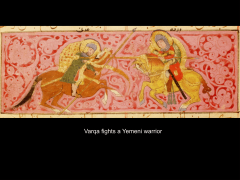
|
Varqa fights a yemeni warrior Varqa and Gulshah 1250's Anatolia BGs are psychedelic, swirly, trees plants and animals comment on action in the main scene. Varqa is wearing metal mail headpiece- influence from crusaders. |
|
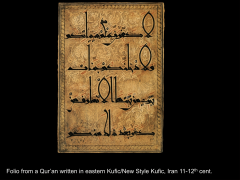
|
Folio from a Quran written in Eastern/New Style Kufic Iran 11th-12th c |
|
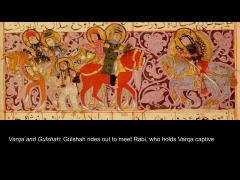
|
Varqa and Gulshah, Gulshah rides out to meet Rabi, who holds Varqa captive Anatolia 1250's Partridge reflects that Rabi is foolish and easily decieved No shirt=prisoner |
|
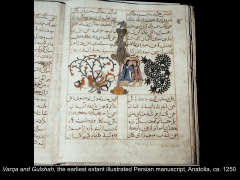
|
Varqa and Gulshah Earliest Illustrated Persian Manuscript 1250's Anatolia |
|
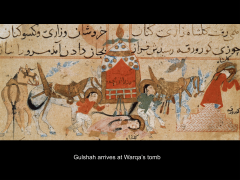
|
Gulshah arrives at Varqa's tomb 1250's Anatolia |
|
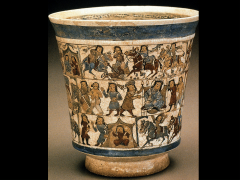
|
Minai Vessel in 3 registers Love story from Shahnama Bijhan and Rustam Story set in Turan borderlands Artist makes use of Generic Stock Images to convey details of story, such as enthronement, but uses context to make them specific and let us know this is a particular story. There's a comic book gestural aspect Frames |
|
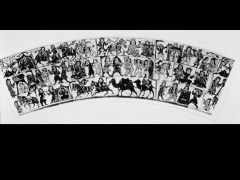
|
Minai vessel in 3 registers Love story of Bijhan, Shahnama, rescued by Rustam |
|

|
Minai vessel in 3 registers |
|
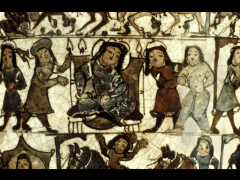
|
Minai vessel in 3 registers |
|
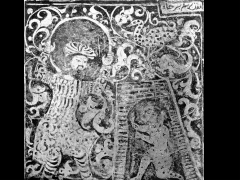
|
Fragment of Seljuq wall painting feat. Rustam... i think... no label thx professor |
|

|
Seljuq Steel Mirror Early 13th C Anatolia genre of lit called mirror for princes which taught rulers how to behave was popular at the time horse trampling a dragon, which is basically a bigger-than-usual snake connects to christian iconography of saints spearing dragons |
|
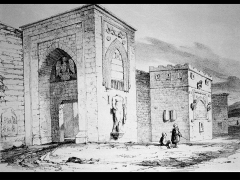
|
Walls of Konya, Seljuq Capital 1220 reuse of sculpture elements from Byzantium double headed eagle over gate, classic statue of Heracles, a shrine for Plato, who was a Muslim "saint" they reinterpreted hercules as plato many statues created explicitly for walls of konya very eclectic, also collages that basically illustrate the heritage of the seljuqs in the area (byzantine seljuq combo) - reference to persian kingship and greco-roman past both arabic and persian monumental inscriptions |
|
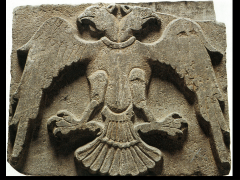
|
Fragmentary Stucco wall decoration Konya 1220 double headed eagle is insc |
|
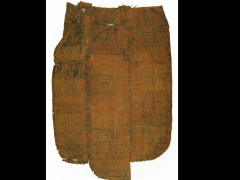
|
Red Silk bearing name of Ala-al Din Kay Qubad 1220-37 (Dude who built Konya) Red is a royal color in both the islamic world and Byzantine empire (emperor shoes) Maybe piece of a tent |
|
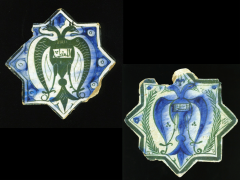
|
Minai Tiles Kobadabad 1220 Made by KAshan craftsmen for Kobadabad summer palace near Konya Double headed eagle inscribed "sultan" and "the greatest", this is alzo a Byzantine image |
|

|
Karatay Madrasa Konya 1253 Entrance Portal 4 iwans no courtyard in anatolian mosques0 too cold large central dome covers would-be courtyard karaty is named for seljuq vizier who built it mosaics are tile pieces in mortar, some with gold leaf, symbols from all over including solomon some of the content explained on the deed |
|
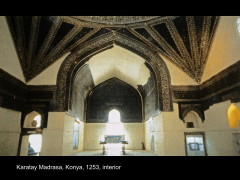
|
Karatay Madrasa Konya 1253 Interior pendentives hold up the dome pendentives highlighted as decorative bit |
|
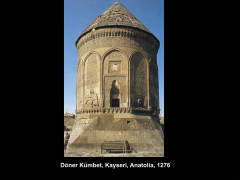
|
Doner Kumbet Kayseri Anatolia 1276 Tomb/Tomb-tower stone, which is the main building material up here elevated on prismatic base like an inverted pendentive highly developed enbalming craft extremely richly decorated with patterns, plants and animals |
|
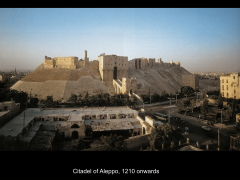
|
Citadel of Aleppo 1210 Onwards heavily fortified homes built in city centers during countercrusades, one extremely difficult to access entrance, impossibly steep walls, moats 4 iwan plan, built by son of Salah-al-Din |
|
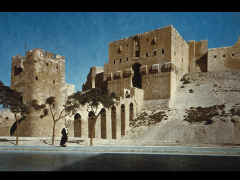
|
Citadel of Aleppo 1210 Onwards |
|

|
Citadel of Aleppo 1210 Onwards |
|
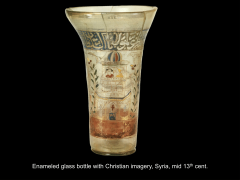
|
Enameled glass bottle with Christian Imagery Syria 13th C (drily) remember all your research |
|
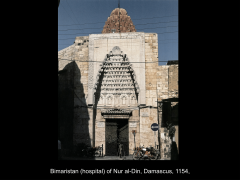
|
Bimaristan of Nur Al-Din, Damascus, 1154 Nur Al-Din was a key figure in mobilizing countercrusade he saved damascus from crusader siege, unites aleppo and damascus for first time since umayyad pd. he invests heavily in damascus, his chosen capital. he is sunni and professes allegiance to abbasids, and as a pious ruler he is obligated to provide infrastructure such as this entrance has a muqarnas dome, doorway has reused roman pediment on top, brought from nearby roman temple immediate signatures of syria's relationship to contemporary iraq and roman past 4 iwan plan |
|

|
Tomb of Zumurrud Khatun Baghdad 1200 |
|
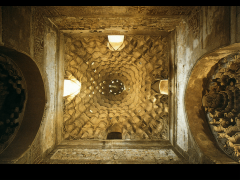
|
Bimaristan of Nur Al-Din Damascus 1154 4 iwan plan stucco muqarnas dome pierced with glass to intensify play of light |
|
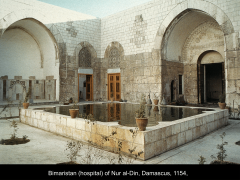
|
Bimaristan of Nur Al-Din, Damascus, 1154 4 iwan plan |
|
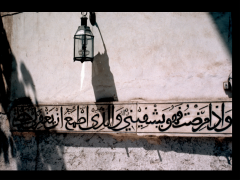
|
Bimaristan of Nur Al-Din Damascus 1154 great change in the way inscriptions are articulated happens during Nur al-Din's time frieze is white marble with inlaid black, written in cursive and fully vocalized, all vowels in. very concerned with legibility. |
|
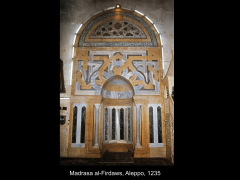
|
Madrasa Al-Firdaws Aleppo 1235 (Paradise Madrasa) built by saladin's daughter in law, whose husband built Aleppo citadel rise in female patrons at this time (12th 13th c) enter through an iwan facing an open space, unusual plan 1 iwan built same time as Konya and reflects seljuq developments yellow green and grey geometric patterns in marble decorate the mithrad dome supported by pendentives covered by muqarnas |
|
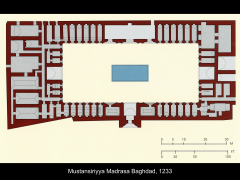
|
Mustansiriyya Madrasa Baghdad 1233 caliph al-mustansir (abbasid) establishes fraternity of sons of sunni dynastic elite to galvanize their allegiance promotes sunni acumenism- heals intra-sunni tensions between 4 schools of sunni law, they're all taught here |
|
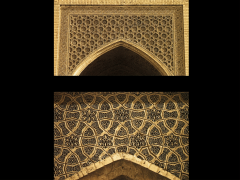
|
Mustansiriyya Madrasa Baghdad 1233 first madrasa founded by a caliph has a hospital a bath and a great library |
|

|
Mustansiriyya Madrasa Baghdad 1233 geometric brickwork increase in legibility of insctiptions inscripitions also meant to reassert abbasid authority |
|
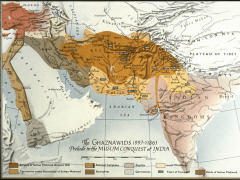
|
Ghaznavid empire Ghaznavids are turkic people who come to power in 997-1186 great rivals of seljuqs |
|
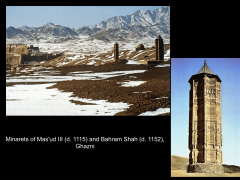
|
Minarets of Mas'ud III (d 1115) and Bahram-Shah (d 1152), Ghazni minarets made of terra cotta, there used to be mosques made of unbaked brick attached but those melted away with time indian artisans built a lot of this stuff, some were slaves and some came for patronage |
|
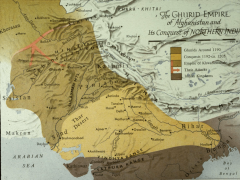
|
Ghurid Empire 1150-1216 the place they take over is a remote backwater with no major political developments ghurid chiefs, seen as backwards people, march on Ghazni and manage to sack it, somehow they adopt turkic dress at the advice of a jewish merchant, jewish merchants conected this place with the wider islamic world |
|
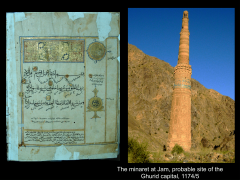
|
Minaret of Jam Probable site of Ghurid Capital 1174/5 associated with a mosque which is now gone ghurid homeland is bare of architecture now, floods too often this minaret stands 60m tall, telescoping muqarnas moldings 2 taircases inside geometric panels framed by narrow bands of inscriptions, names of the sultan as well as the chapter of the quran dedicated to the virgin mary ghurids were splinter group sunnis with a particular belief in an embodied god, which got them ridiculed by most of the islamic world mary sections address birth of jesus, yipes the most important section is placed so that if you're reading it, you're facing mecca organization of text so complex it must have been planned on paper Also richly gilt Quaran with Intralineal translation 1180's Persian is lower than Arabic hierarchically, so it's smaller and at a slant |
|
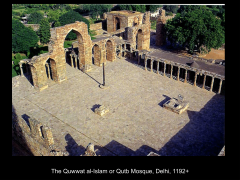
|
The Quwwat-al-Islam Mosque (AKA Qutb Mosque) Dehli 1192 + materials mostly reuse from hindu and jayan temples ghurids destroyed the central temple in each conquered city, told the rest of the islamic world that they were "destroyers of idols" this mosque is raised on a plinth, like hindu temples are prayer hall is rund with a series of dome |
|

|
The Quwwat-al-Islam Mosque (AKA Qutb Mosque) Dehli 1192 + iwan is an important visual element in mosques, so we have one, but it's really an iwan-like arch certain decorative elements, like hindu gods, are destroyed, but stuff such as lions which can be reused, are kept. Just like the umayyads in persia, they keep a selection of elements from the area's pre-islamic past. |
|
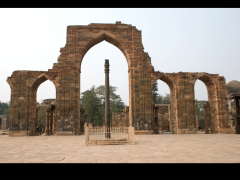
|
The Quwwat-al-Islam Mosque (AKA Qutb Mosque) Dehli 1192 + |
|
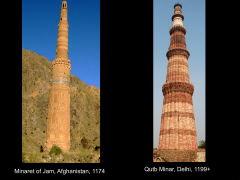
|
Minaret of Jam- Afghanistan, 1174 vs Qutb Minar, Dehli, 1199+ Qutb Minar is built telescopically as well, but scalloped built in stone built by indian craftspeople in service of persian rulers how did they carve quaranic inscriptions if they were indian and didn't speak arabic? possibly with cartoons, or possibly some had previously worked in afghanistan. |

